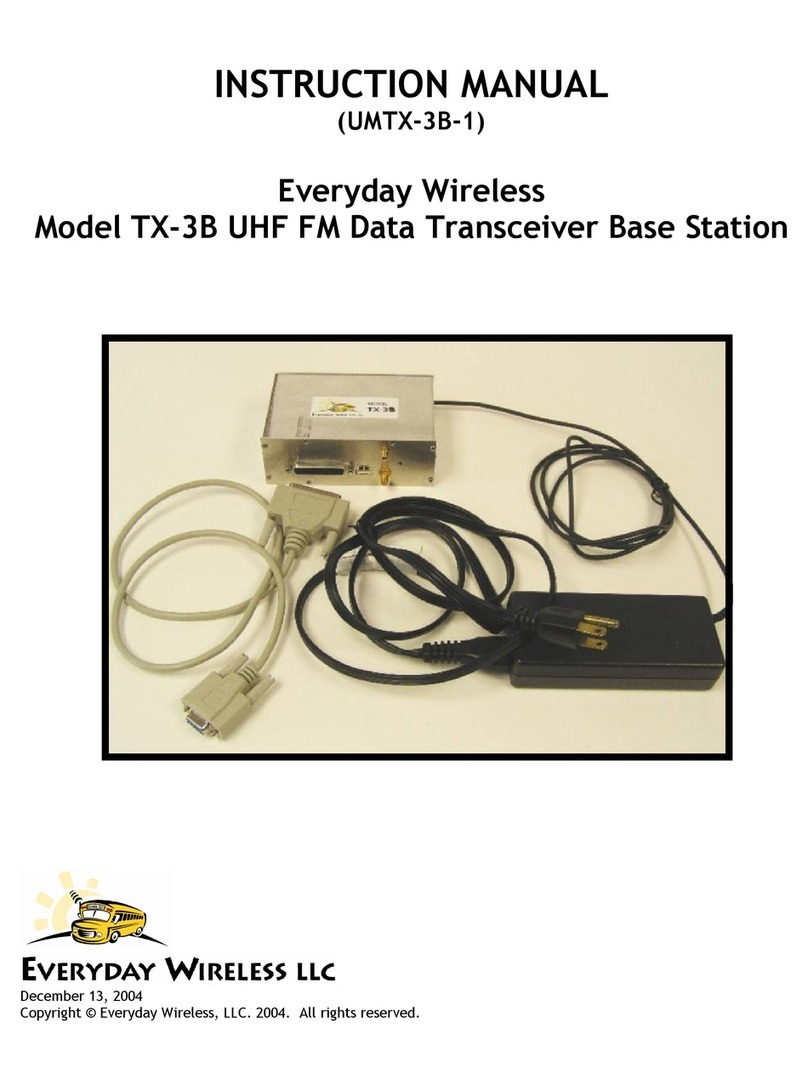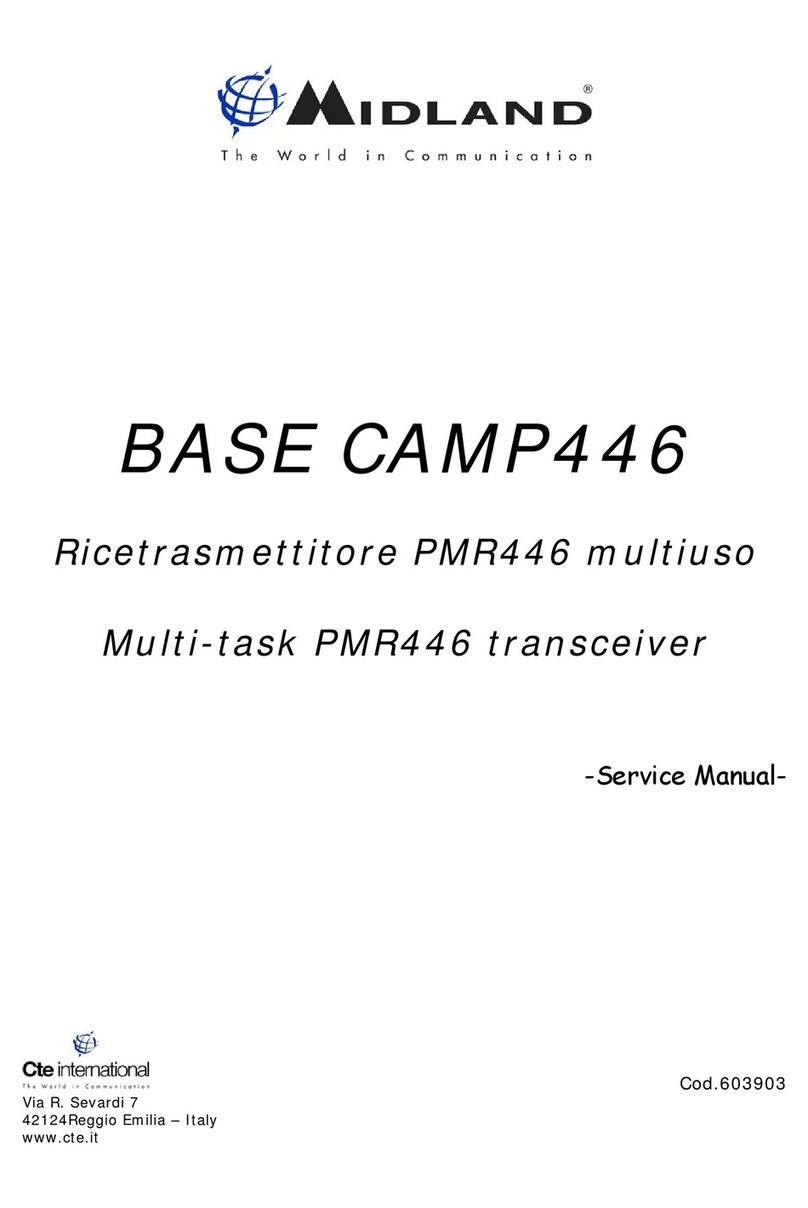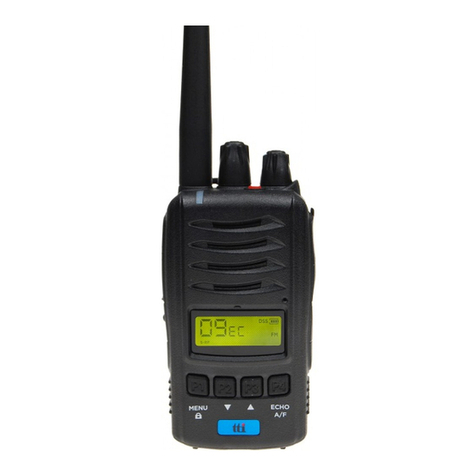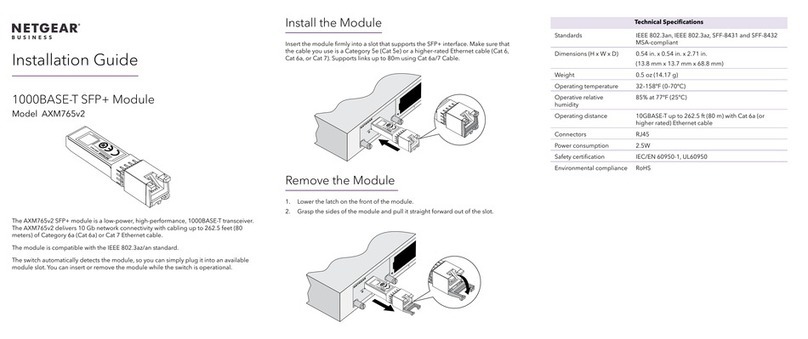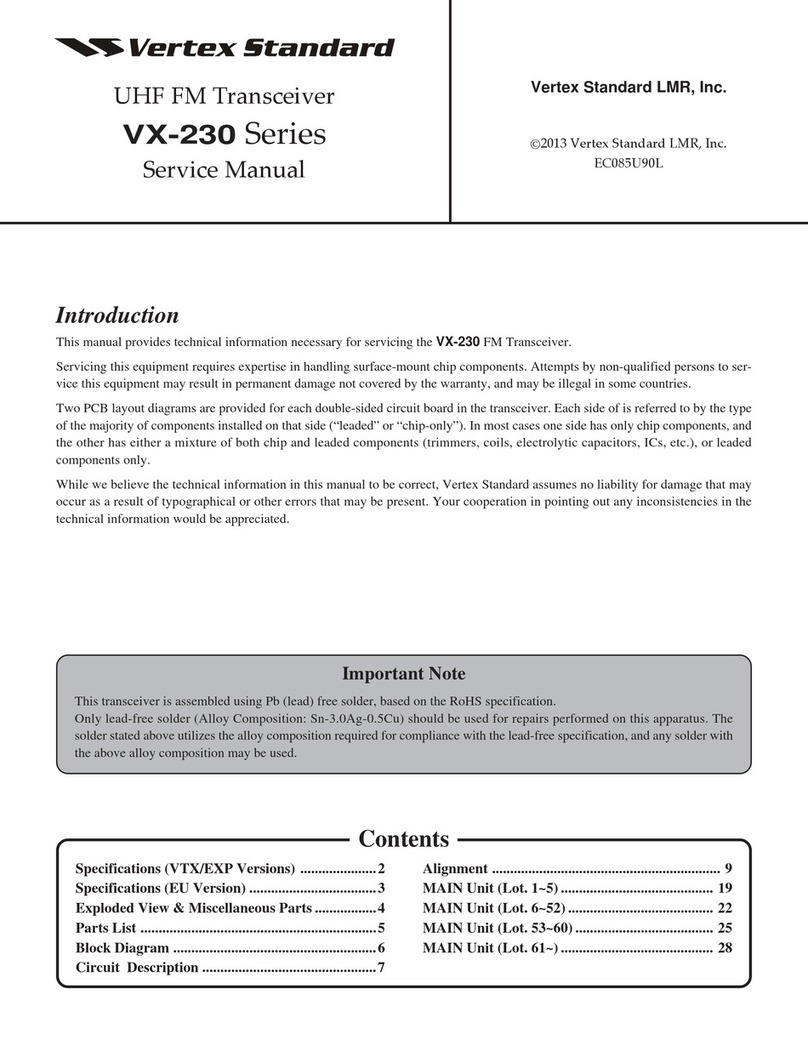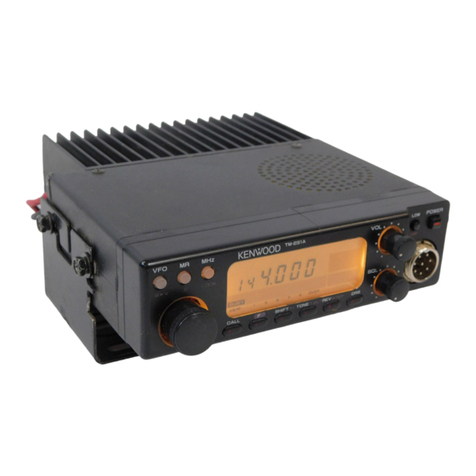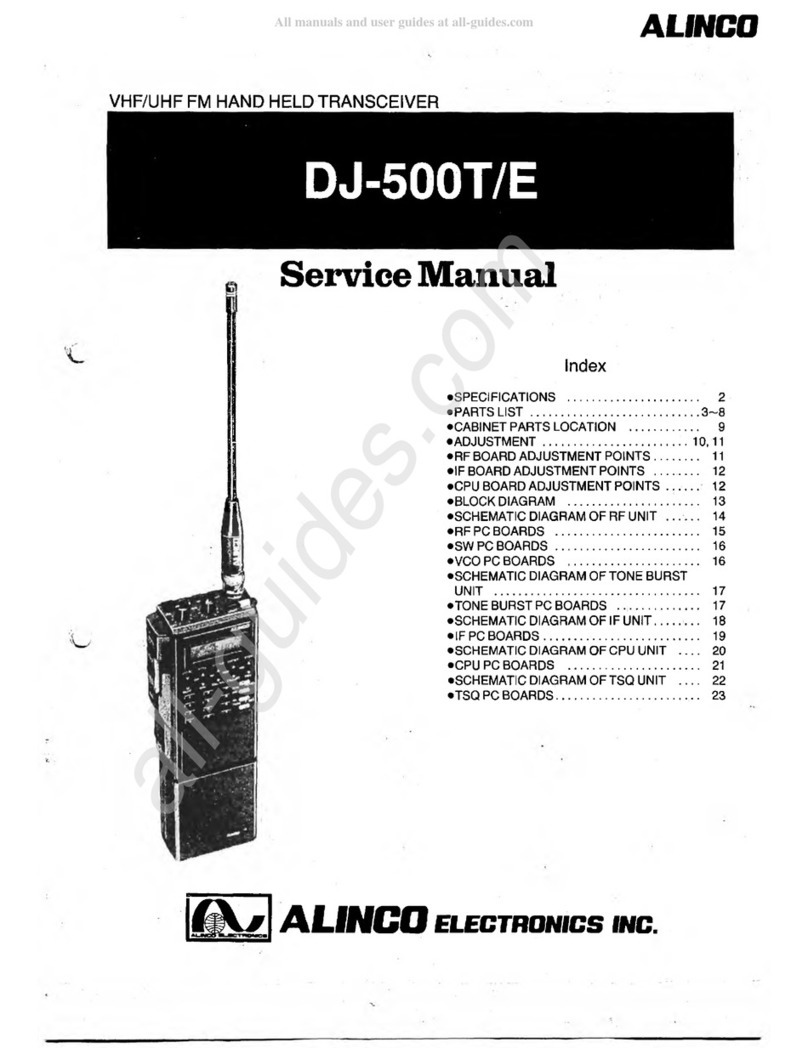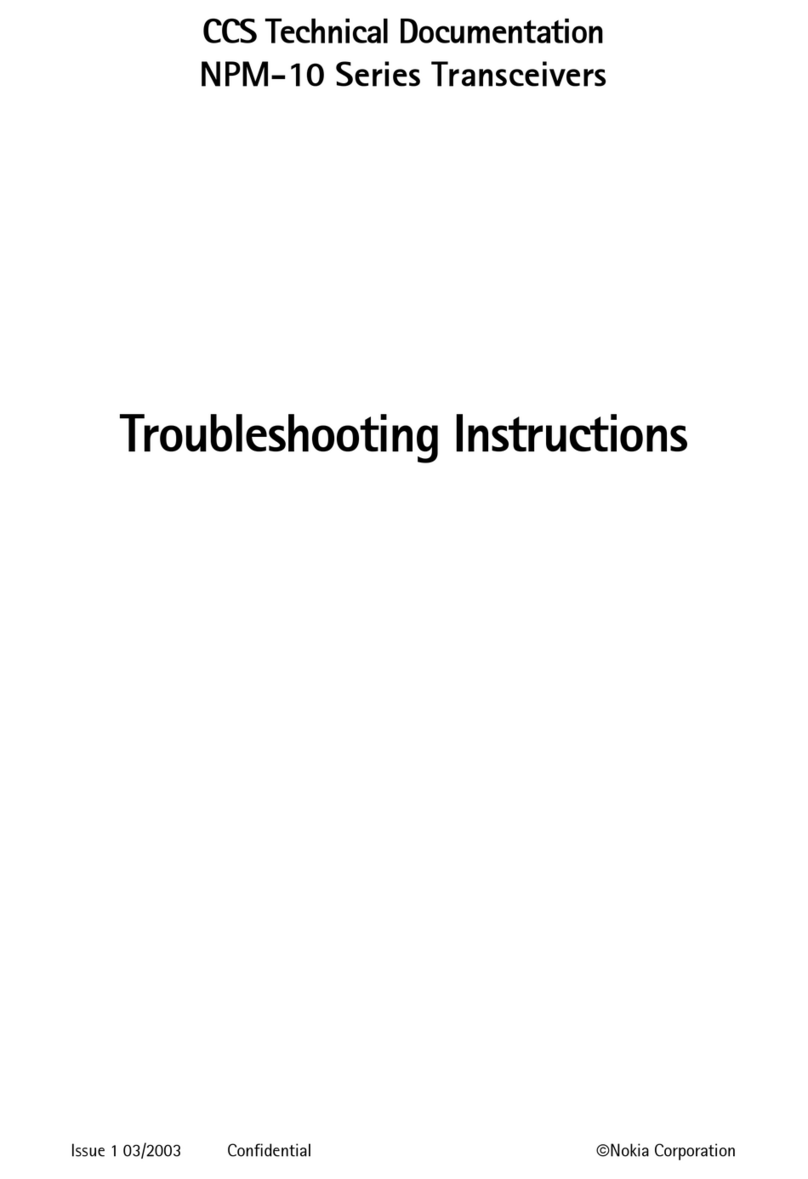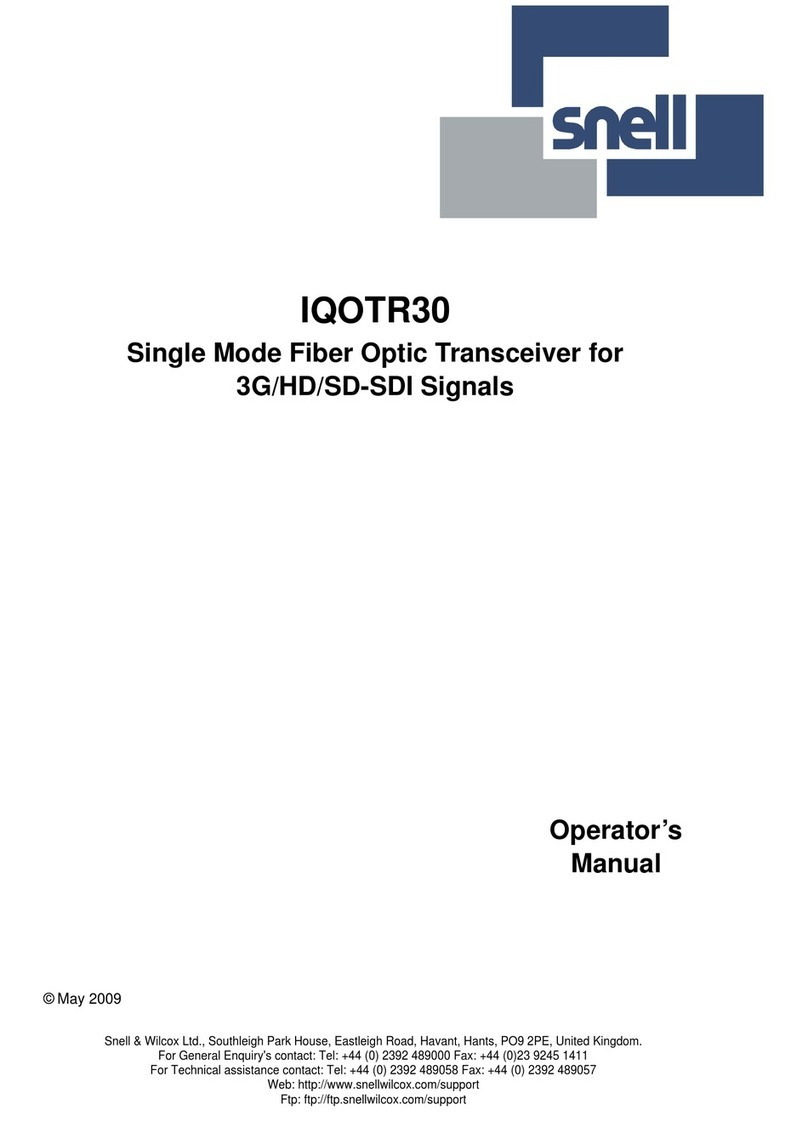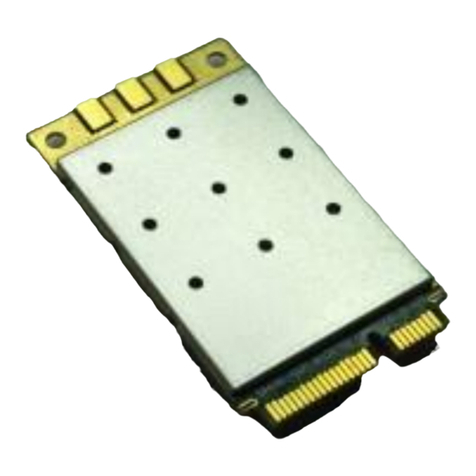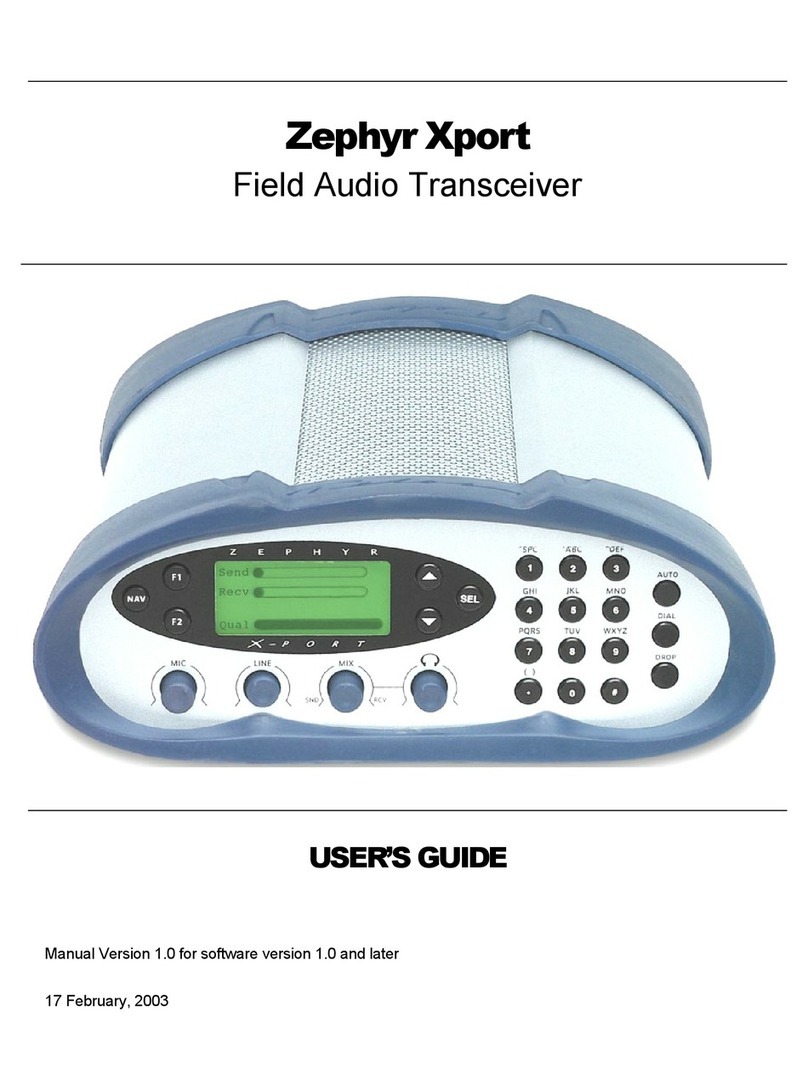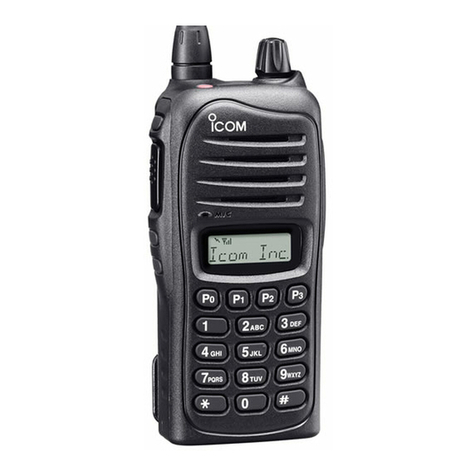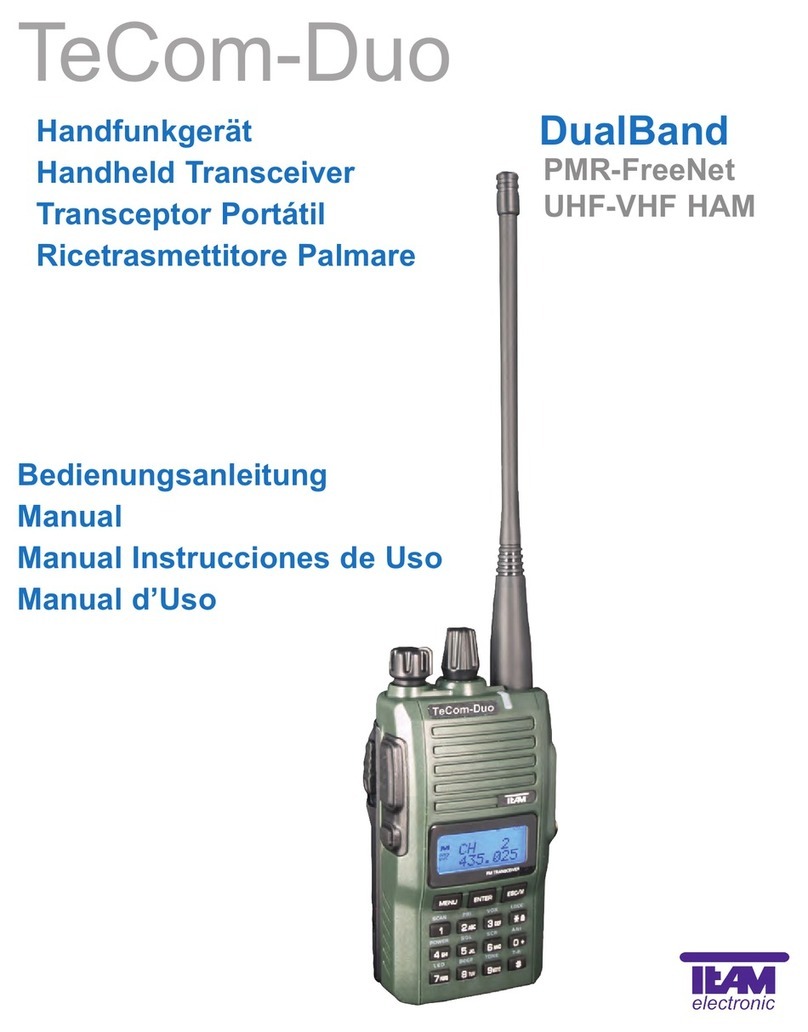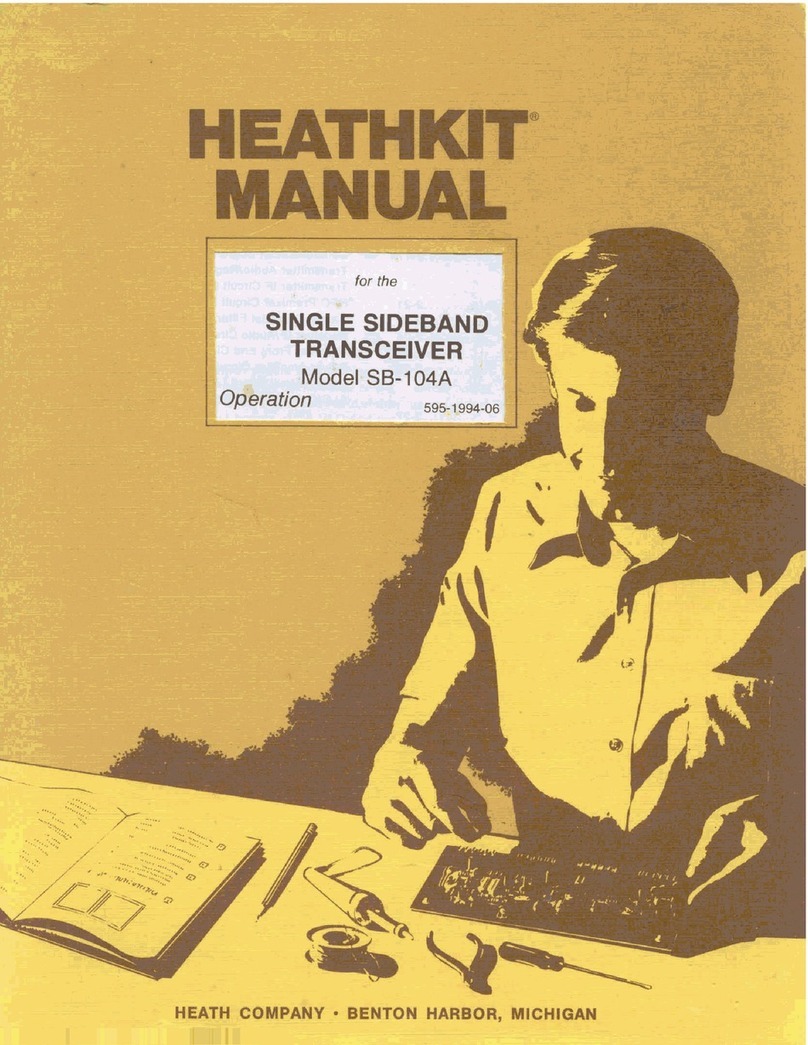Everyday Wireless TX-3 User manual

! "#$

i
Thank you for purchasing the Everyday Wireless Model TX-3 UHF FM Data Transceiver. Before
proceeding with the equipment installation, it is imperative that you read the following pages of notices and
precautions. In order to ensure your equipment installation complies with FCC specifications and fulfills all
warranty-related obligations, read comprehensively the IMPORTANT USER NOTICES and PRECAUTIONS
sections below.
IMPORTANT USER NOTICES
• FCC WARNING: This equipment generates or uses radio frequency energy. Changes or modifications
to this equipment may cause harmful interference unless the modifications are expressly approved in the
instruction manual. The user could lose the authority to operate this equipment if an unauthorized
change or modification is made.
• FCC RF Exposure Requirements: The antenna included with the Model TX-3 Transceiver must be
installed to provide a separation distance of at least 20 centimeters from all persons, must not be co-
located or operating in conjunction with any other antenna or transmitter, and must not exceed the
antenna gain specified in the Antenna Use description below. Failure to observe these restrictions will
result in exceeding the FCC RF exposure limits.
• Antenna Use: The AU2-UHF antenna is included with the shipment of each Model TX-3 Transceiver.
DO NOT use any other antenna with the Model TX-3 Transceiver or modify the antenna / coaxial
cabling without first consulting with Everyday Wireless or an Everyday Wireless qualified service
organization. The included AU2-UHF antenna is a quarter-wave, omni directional antenna with 3 dBi of
gain, and integral GPS antenna. The RG-58 UHF coaxial cable line has a minimum loss of 1.0 dB.
• Accessories: The accessories supplied with the Model TX-3 GPS transceiver are specifically designed
for the Model TX-3. Use of other accessories may severely degrade performance or even damage the
transceiver, and will void the warranty.
• Component Access: There are no service accessory parts inside the transceiver. Do not try to open the
transceiver without prior approval from Everyday Wireless. Opening the transceiver will void the
warranty.
• Service: Only qualified service personnel must install or repair equipment.
PRECAUTIONS
• Do not modify the transceiver for any reason.
• Do not expose the transceiver to long periods of direct sunlight, nor place it near heating appliances.
• The Model TX-3 UHF FM Transceiver transmits data in the 450-470 MHz frequency band, which is
regulated in the United States by the FCC. Because the FCC grants access to specific frequencies, and
can grant access by multiple users to the same frequency, system performance may be affected by the
presence of other nearby users of the frequency used by the owner of this transceiver.
• The United States Government is responsible for the operation, accuracy, and continued operation of the
Global Positioning System (GPS). Accuracy and position fixes (latitude, longitude and altitude) can be
affected by alterations made to the GPS satellites by the U. S. Government. Accuracy is subject to

ii
change in accordance with the U. S. Department of Defense civil GPS user policy and Federal Radio-
navigation Plan. Positional accuracy and time to fix time can also be affected by poor view caused by
obstructions such as tall buildings, heavy foliage, and large cliffs or other obstructions where GPS
satellite signals are blocked and poor satellite geometry conditions result.
DISCLAIMER AND LIMITATION OF LIABILITY
• Under no circumstances shall Everyday Wireless be responsible for any loss of data or any special,
incidental, consequential, or indirect damages howsoever caused. Everyday Wireless assumes no
responsibility for any damage or loss caused by deletion of data as a result of user error, malfunction, or
repairs.
• Everyday Wireless LLC assumes no responsibility for any damages or loss resulting from the use of this
product and user guide. Everyday Wireless LLC assumes no responsibility for any loss or claims by
third parties that may arise through the use of this system.
• The contents of this User Guide are provided “as is”, except as required by applicable laws, no
warranties of any kind, either express or implied, including but not limited to, the implied warranties of
merchantability and fitness for a particular purpose, are made in relation to the accuracy, reliability or
contents of this user guide. Everyday Wireless reserves the right to revise this user guide or withdraw it
at any time without prior notice. Everyday Wireless reserves the right to make changes and
improvements to any of the products described in this user guide.

iii
CONTENTS
Section 1 – Introduction ......................................................................................................................... 1
1.1 Product Description and Basic Operation................................................................................. 1
1.2 Technical Specifications........................................................................................................... 2
Section 2 – Receiving, Inspection, and Installation ............................................................................. 3
2.1 Packing Contents and Inspection.............................................................................................. 3
2.2 Installation ................................................................................................................................ 3
Section 3 – Maintenance......................................................................................................................... 5
3.1) Maintenance Concept ............................................................................................................... 6
3.2) Preventive Maintenance Requirements .................................................................................... 6

Section 1 - Introduction
1
Section 1 – Introduction
Note: Make sure you have read the IMPORTANT USER NOTICES and PRECAUTIONS sections
before proceeding with the installation instructions.
1.1) Product Description and Basic Operation
The Everyday Wireless Model TX-3 is a synthesized UHF FM data transceiver designed to operate in the
frequency range of 450 to 470 MHz. There are no user controls or adjustments.
The Everyday Wireless Model TX-3 is a half-duplex data communications device providing radio frequency
(RF) data transmit and receive functions. The Model TX-3 transceiver is an all-inclusive unit containing a
synthesized UHF data radio, GPS receiver, and supporting processing overhead to gather, compute, and transmit
vehicle information in real-time. The Model TX-3 design is intended to be used for 12.5 kHz channel data
telemetry applications.
Each Model TX-3 comes pre-programmed to a specific frequency licensed to each user. Reprogramming the
unit to a different frequency can only be accomplished by the manufacturer.
The Model TX-3 processes GPS information and the status of multiple vehicle inputs. Each Model TX-3
transceiver is configured to transmit data packets containing position, vehicle, and trip information at a
predetermined interval (typically every 10 seconds).
The Model TX-3 unit also comes pre-programmed with a vehicle transceiver identification number that dictates
its transmission time slot. When the time slot corresponding with the pre-programmed vehicle number is
approaching, the Model TX-3 prepares its encrypted data packet, checks to make sure the channel is clear, and
then bursts the data at its precise time slot time interval. Because data packets from the Model TX-3 burst
(typically 25 msec.) in a proprietary time slot protocol, message collisions are avoided and higher throughputs
are achieved.
The Model TX-3 has no user adjustments. Maximum output power is pre-set to 45 watts. The Model TX-3
Transceiver unit should only be opened by the manufacturer.

Section 1 - Introduction
2
1.2) Technical Specifications
% #
!"#$" %&'( ) *+",
""-#" %.) *
!"#- /%
-!0 1203 /%4
-!!"
5" 6'%7 1203
$# 6 7 1203
-* %89 :1%8:'%8
;%!"
""#<
=9 "9 #""#
$ -( >#.
? =- ( :>#.
5 !+", &%/%%
5 !+, &1/@
3!# 5" <64
"""A "# %
3$ B C2
#& ""
$=9 D !! %9 ;
( !"E "3" F13
$;5;-9 #"5 6% #
-!!") "#D !! G'H#
$
-"+H-A 3 , 6&1H
A $>#" G2H
A" !"$>#" G2H
H#." G'%H
>#""" G2H
A" !"# %( ) *"%%.) *

Section 2 – Receiving, Inspection,
3
and Installation
Section 2 – Receiving, Inspection, and Installation
Note: Make sure you have read the IMPORTANT USER NOTICES and PRECAUTIONS sections
before proceeding with the installation instructions.
2.1) Packing Contents and Inspection
Carefully unpack the transceiver and other installation items. Identify all of the items listed in the following
table before discarding the packing material. If any items have been damaged during shipment, file a claim with
the carrier immediately.
Supplied Accessories
"& ' "& (")& * + )#""
B ) 35"# ( 5:&1
=9 # = 5:&1&
! +'% I!, 5:&1&
% &9 """+B ) E? =-, B &B )
2 ( !"""#9 ( -5:&1&1
' B "! B ( 5:&1&
2.2) Installation
WARNING! VARIOUS ELECTRONIC EQUIPMENT IN YOUR VEHICLE MAY MALFUNCTION IF THEY
ARE NOT PROPERLY PROTECTED FROM THE RADIO FREQUENCY ENERGY WHICH IS PRESENT
WHILE TRANSMITTING. ELECTRONIC FUEL INJECTION, ANTI-SKID BRAKING, AND CRUISE
CONTROL SYSTEMS ARE TYPICAL EXAMPLES OF EQUIPMENT THAT MAY MALFUNCTION. IF YOUR
VEHICLE CONTAINS SUCH EQUIPMENT, CONSULT EVERYDAY WIRELESS OR AN EVERYDAY
WIRELESS AUTHORIZED REPRESENTATIVES TO DETERMINE IF THEY WILL PERFORM NORMALLY
WHILE TRANSMITTING.
Note: The following preparation instructions are for use by your EVERYDAY WIRELESS dealer, an authorized
EVERYDAY WIRELESS service facility, or the factory.
Note: The antenna and transceiver require certain mounting surfaces and environments as described below. If
no suitable mounting surface is available, please contact EVERYDAY WIRELESS for alternative hardware and
mounting solutions.
Tools Required
Note: Before installing the transceiver antenna, always check to see how far the antenna base will extend below
the mounting surface. When drilling the mounting hole, be careful not to damage vehicle wiring or parts.
The following tools are required for installing the transceiver:
• 6mm (1/4 inch) or larger electric drill

Section 2 – Receiving, Inspection,
4
and Installation
• Step drill bit capable of drilling a ¾ inch hole
• 1/8 to 1/4 inch drill bit
• Test light and voltmeter
Antenna and Transceiver Location
Identify a location on the vehicle roof where the antenna will be installed. The antenna should be located on a
flat metallic surface at a minimum of 6 inches from all roof edges. Prior to installing the antenna, identify the
location where the transceiver will be installed.
The transceiver installation location should be in an enclosed area of the vehicle where the power cables and
antenna cables can be easily accessed without potential for damaging the cables. The transceiver location should
also provide protection for the transceiver from moisture and excessive heat.
Once the locations of the antenna and transceiver have been identified, ensure that the antenna cables are
sufficiently long to reach from one location to the other location.
Antenna Installation (AU2-UHF)
1. Drill a starter hole using a 1/8 to 1/4 inch drill bit at the chosen location of the antenna.
2. Use the step drill to drill a 7/8 inch hole to accommodate the antenna.
3. Slide the rubber gasket onto the metal base of the antenna and feed the antenna leads into the
vehicle.
4. Once the antenna leads are inside the vehicle, pass the leads through the plastic wheel nut and the
metal locking nut.
5. Bring the plastic wheel nut and metal locking nut up to the inside of the mounting surface.
6. Secure the antenna in place by tightening the plastic wheel nut and metal locking nut.
7. Feed the antenna leads to the location where the transceiver is located.
Caution: Care should be taken to ensure that there are no kinks in the antenna leads and that the
antenna leads will not be damaged when replacing panels or other interior components that may have
been removed during installation or that may subsequently be removed during vehicle maintenance.
Significant signal strength loss can occur if the antenna leads are subjected to sharp corners and care
should be taken to avoid such circumstances.
Power Cable Installation (PCTX-3-2)
Caution: The Transceiver operates in 12 V negative ground systems only. Check the battery polarity
and voltage of the vehicle before installing the transceiver. Use a test light or voltmeter to ensure that
the transceiver will be powered only when the vehicle key is in the accessory or ignition position.
1. Check to see that there is access from the power source to the transceiver location.
a. If access does not exist, holes should be drilled in a manner that no damage to the vehicle or
its parts will occur.
2. Run the power cable leads from the transceiver to the power source. Keep the plug end of the cable
at the transceiver.

Section 2 – Receiving, Inspection,
5
and Installation
3. Attach the provided fuse assembly (FATX-3-1) to the black lead of the power cable. Locate the
fuse as close to the power source as possible.
4. Connect the free end of the fuse assembly lead to the positive (+) power source of the accessory or
ignition power source.
5. Connect the white lead of the power cable to a suitable vehicle ground connection.
6. Recoil and secure the surplus cable with a suitable cable tie.
a. Be sure to leave enough slack in the cables so that the transceiver can be removed for
servicing while keeping the power applied.
Installing the Model TX-3 Transceiver
Note: Since there are no user adjustments necessary to operate the transceiver, mount the transceiver in
a convenient, yet enclosed and secured location.
1. Find a relatively flat, steel surface on which to mount the transceiver that is within reach of the
antenna cables and power cords.
2. Place the magnet side of the transceiver against the flat surface until a solid mount is made. If a flat
area is not available, contact Everyday Wireless for a mounting bracket.
3. Screw in one of the mounting strap (MSTX-3-3) ends above the top edge of the transceiver (at the
horizontal center of the transceiver). Pull the mounting strap down and over the center of the
transceiver and screw in the other end of the strap below the bottom edge of the transceiver. The
strap should fit tightly over the transceiver.
4. Repeat step 3 with the second mounting strap (MSTX-3-3), but run this mounting strap horizontal,
securing the screws at the left and right edges of the box (at the vertical center of the transceiver).
The strap should fit tightly over the transceiver. The mounting straps should cross in the middle of
the top plate of the transceiver.
5. Connect the antenna leads and the supplied power cable to the transceiver.
Installing Optional Accessories for the Model TX-3 Transceiver
Note: Accessories are supplied with user manuals and installation instructions specific to each
accessory. Please consult Everyday Wireless for a list of accessories and for user manuals and
installation instructions.
1. Each Model TX-3 has a DB25 connection on the transceiver, which is used to connect the TX-3
transceiver to Everyday Wireless vehicle sensor modules. Please consult the user manual of your
specific sensor module for installation instructions.
2. Under no circumstances should any other device or cable be connected to the Model TX-3 except
those supplied or approved by Everyday Wireless.

Section 3 - Maintenance
6
Section 3 – Maintenance
In order to ensure that the Model TX-3 is always ready for operation, it should be checked periodically so
that potential defects may be discovered and corrected before they develop into any serious damage. A
minimal preventive maintenance program will significantly increase the transceiver’s lifespan.
This section describes the necessary preventive maintenance checks and tests the user can perform to easily
identify most defects and problems. Any other defects or problems discovered during the normal operation of
the system should be noted for future corrective measures.
CAUTION:
This section also describes the corrective maintenance checks that can be performed on the transceiver.
3.1) Maintenance Concept
The maintenance concept for the transceiver is limited to the removal and replacement of the entire unit.
3.2) Preventive Maintenance Requirements
The following is a recommended timetable for performing preventive maintenance checks on the transceiver.
CAUTION:
Inspection
The transceiver should be inspected at least every three (3) months for defects or physical damage developed
during operation. Inspect all the interface cables to and from the system for cracks, breaks, and proper seating
with their mating connectors on the faceplate. Inspect all cables for frayed, broken, or damaged wires. In
addition, inspect all transceiver connections for accumulation of dirt, grease, or any foreign material that can
cause a non-connection. If a cable is found damaged or non-repairable, it should be replaced before operating
the system again.
1. Confirm that the power cord plug is firmly locked into place at the transceiver unit.
2. Verify that the GPS MCX connector is securely in place. Push to confirm that the MCX jack has
remained securely locked into its connector.
3. Verify that the UHF SMA connector is securely fastened.
a. Rotate the SMA connector clockwise to ensure the connection is tight.
4. If applicable, verify that the Everyday Wireless vehicle sensor module connection is firmly
connected to the Model TX-3 transceiver’s DB25 port.
The frequency of inspection should be increased for units exposed to dusty or heavy particulate environments.
Stop the operation of the transceiver immediately if a problem is noted
during normal operation that can otherwise damage the system.
Primary power to the transceiver must be turned OFF when performing
preventive maintenance on the equipment.

Section 3 - Maintenance
7
Cleaning
Clean the outside surfaces and areas around the connectors once a year. Clean the surfaces with a clean, soft,
lint-free cloth. Clean the areas around the connectors with a soft bristle brush. To remove grease, fungus, or
corrosion, use a cloth dampened with an appropriate electronics cleaning fluid. The frequency of cleaning
should be increased for units exposed to dusty or heavy particulate environments.
Table of contents
Other Everyday Wireless Transceiver manuals
